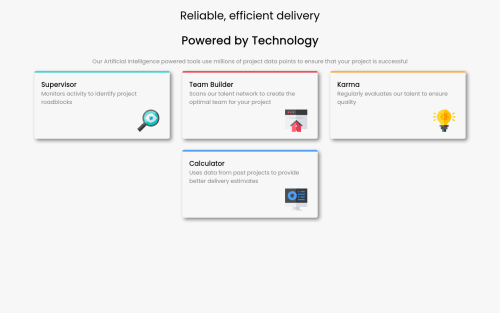four card feature section using html and css (full responsive)

Solution retrospective
hi there, uploading 5th webpage. pls let me know any correction and suggestions
thank u
Please log in to post a comment
Log in with GitHubCommunity feedback
- @thisisharsh7
Hey Yathish, well done! The effort you put into it is really impressive. Your web page is well designed.
There are few changes that could be made
- You can use flexbox and grid for the page to be responsive at different widths.
- The card will not resize itself at different sizes if both height and width are set, so use relative units here .
hope this helps you, happy coding✌️.
Marked as helpful - @LysitheaDarkKnight
Hello, how are you? Good job on completing the challenge!
In order to match the layout shown in the exercise, you would need to use Grid. To do that, create a
divthat covers all the cards and applydisplay: gridto that div. You would then need to apply grid properties accordingly to acheive the layout. You can look at my solution on how I did it or study the Grid component and how it works.Happy coding!
Marked as helpful - @AdrianoEscarabote
Hello Yathish, how are you? I truly loved your project's outcome, however I have some advice that I hope you'll find useful:
You have used <br> , using <br> is not only bad practice, it is problematic for people who navigate with the aid of screen reading technology. Screen readers may announce the presence of the element. This can be a confusing and frustrating experience for the person using the screen reader. You can read more in MDN.
The most appropriate in this case would be just an
h1tag! containing the two contents, to make them break a line, we can use a max-width, and for the styling we can use a span element with the content that will be changed!<h1 style="font-weight: lighter;">Reliable, efficient delivery</h1> <h1>Powered by Technology</h1>The remainder is excellent.
I hope it's useful. 👍
Join our Discord community
Join thousands of Frontend Mentor community members taking the challenges, sharing resources, helping each other, and chatting about all things front-end!
Join our Discord